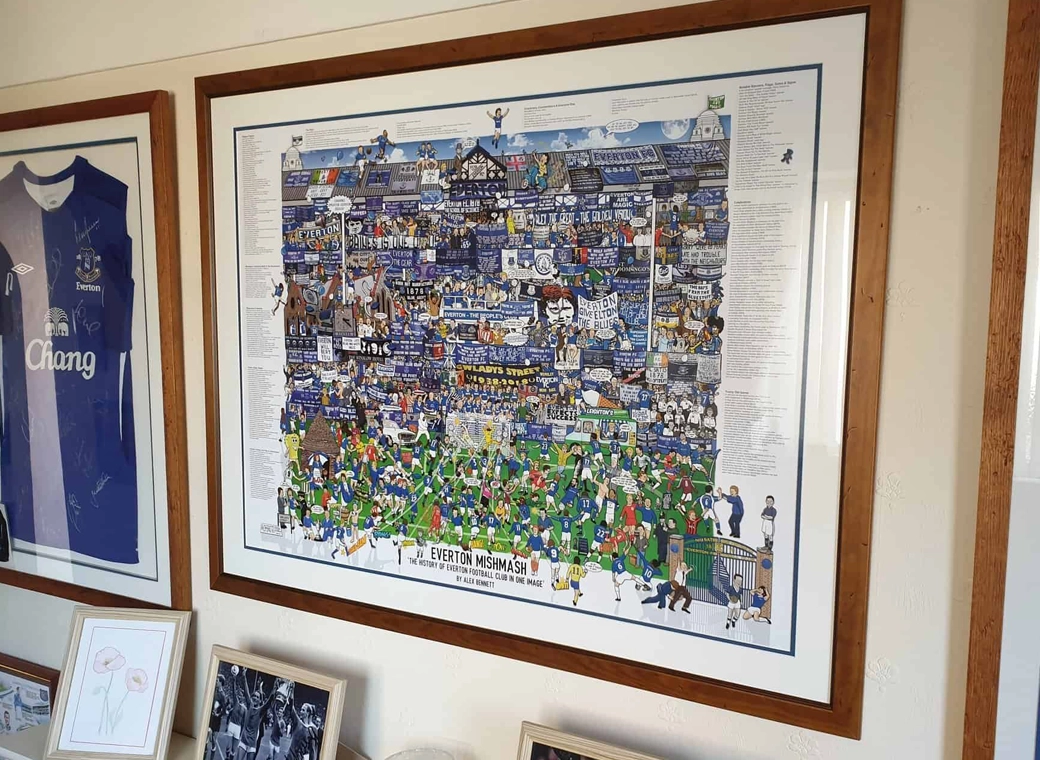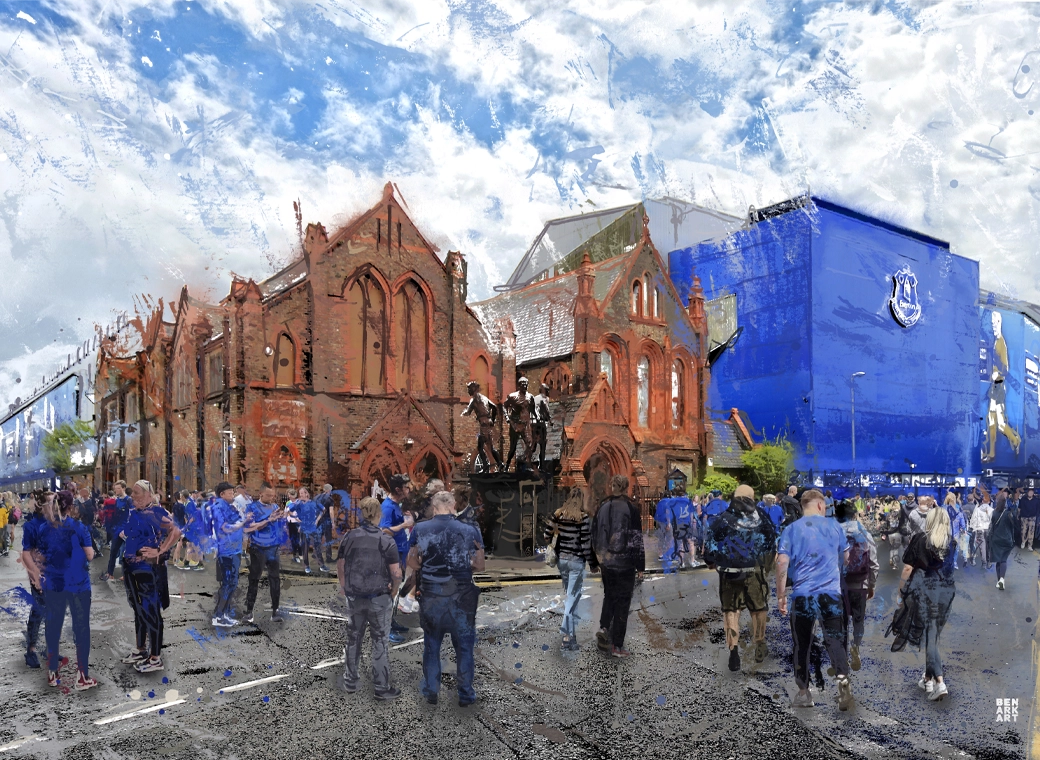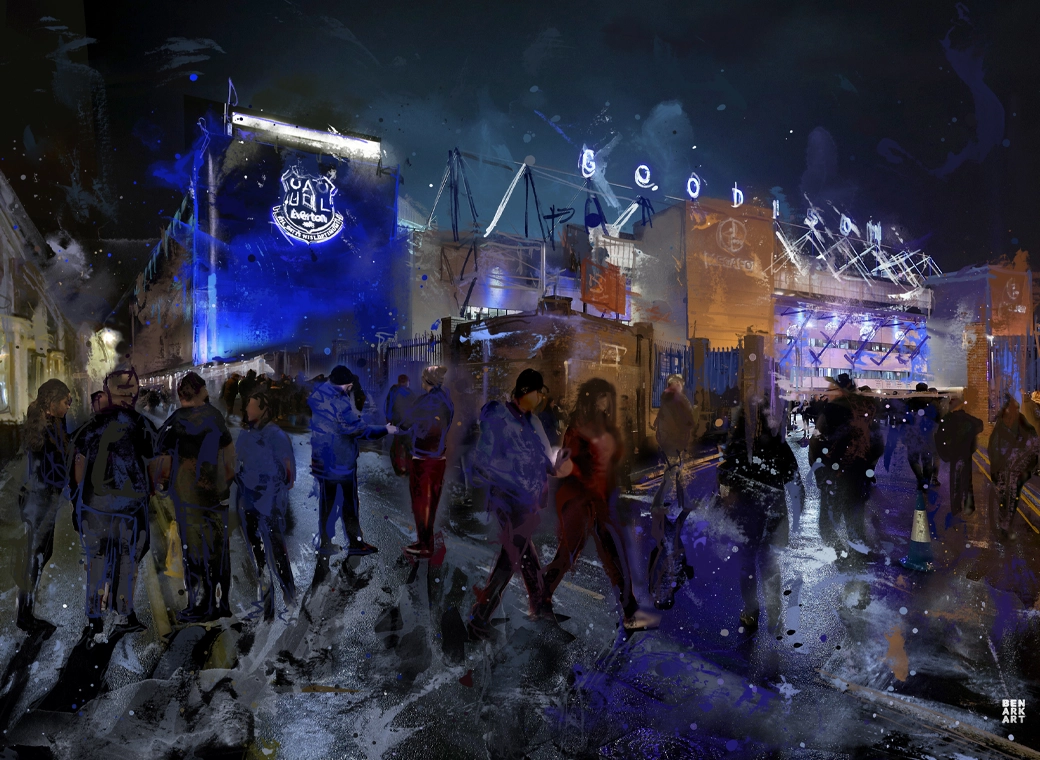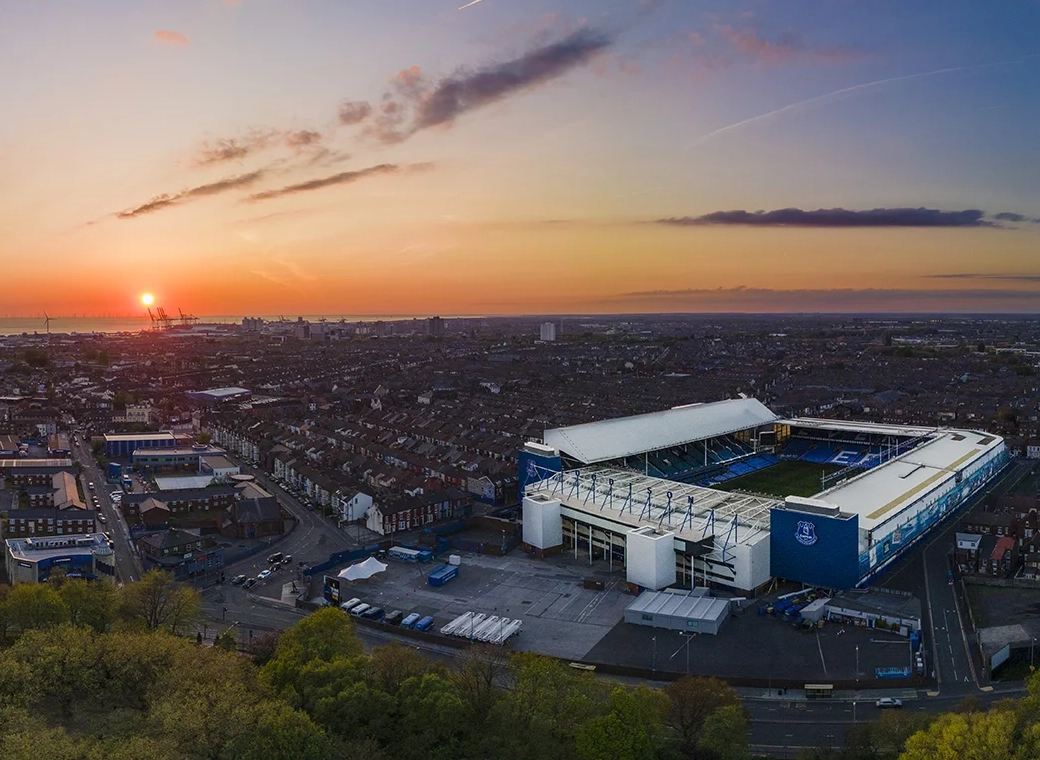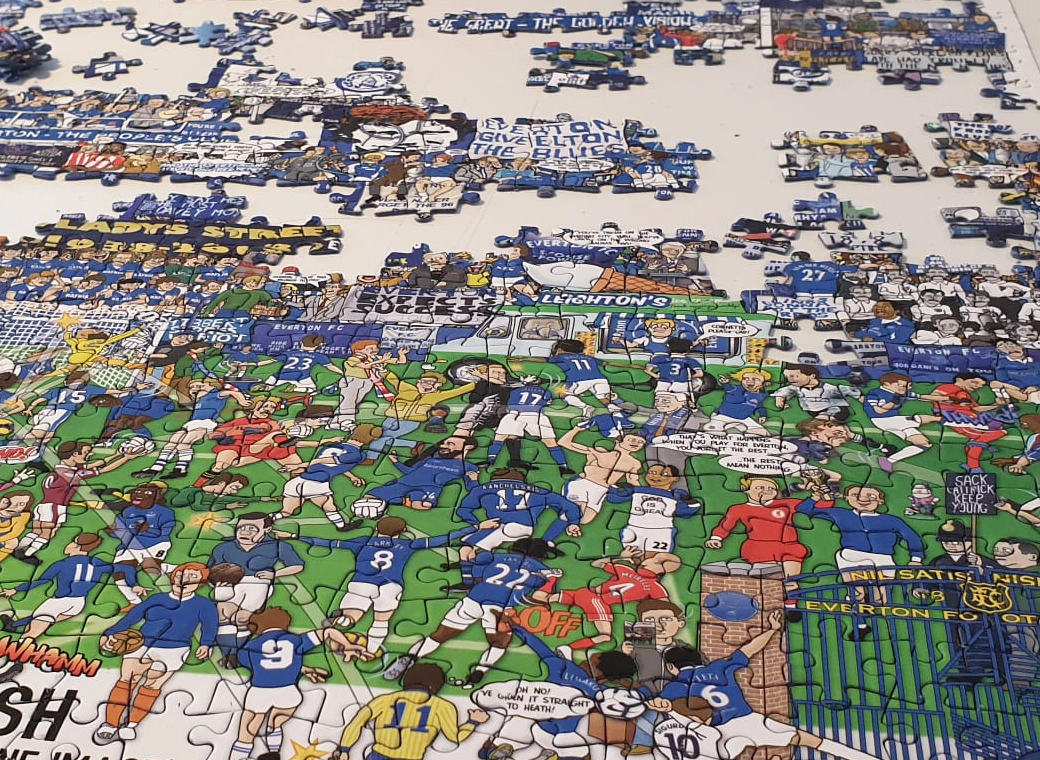A very young Raymond Wilson - he regretted not moving to us when he was younger - but he was tied down on a ten year deal which players honoured back then - he stared off as a left-winger under a certain Mr Bill Shankly -

You are using an out of date browser. It may not display this or other websites correctly.
You should upgrade or use an alternative browser.
You should upgrade or use an alternative browser.
Neville Southall refusing pleas from kit man Jimmy Martin to go and collect his Zenith Data Systems Cup losers medal 7th April 1991 Wembley - typical NEV -  -
-

 -
-FA Cup Semi Final match at Highbury. Everton 1 v Southampton 0 after extra time. Everton's Andy Gray tries to avoid a group of fans who have run onto the pitch at the end. 16th March 1984 - fighting broke out at full time too -

Gary Lineker on his debut in the Charity shield -Trevor Stephen & Inchy scored for the blues -for @Linerkers legs & co -

Bally with a bit of ballet -

Now, that was a midfield pairing. Reidy & Brace. The 'high press' is nothing new... -

Bally & Harvey - & Tommy Wright -

Due to wartime restrictions, no report appeared in the local news, but a photograph of thedamaged Bullens Road outer wall appeared two days later, described as ‘The rear of the standof a well-known football ground in north-western town’, still keeping to war-time anonymity.Detailed news of the damage was even kept from Everton fans who were due to attendGoodison only three days after the bombing for a first team match against Chester in thenewly organised war-time Northern League. The game went ahead with no reference at all tothe state of the stands - the match reports later concentrating instead on Tommy Lawton’ssixteen-minute hat-trick in a 4-3 victory. However, this was to be no full-to-capacity 70,000attendance, later witnessed at several post war games, as government war-time restrictionsalso prevented the gathering of large crowds, which included football grounds, and manyregular fans were already called up or engaged in war work. Crowds were limited to 8,000 inevacuation areas, and 15,000 elsewhere, although this was gradually relaxed as thegovernment acknowledged the importance of the game as recreation for the working man.Attendances of around 5,000 at Goodison and Anfield became the wartime norm. No doubtmodern Health & Safety measures would see the ground closed until repairs were completed.Different times indeed.[*Archibald Leitch designed stands or full stadiums at over 20 football grounds in the UK and Irelandbetween 1899 and 1939, including parts of Goodison and Anfield. He lived in Formby and died in1939].Mike Royden, Evert
Goodison Under Attack! Merseyside was badly hit by enemy air raids during the Second World War, which peak enduring the May Blitz of 1941. However, the bombing had begun the previous summer, with attacks increasing during September 1940. On the night of 18/19 September, several bombs landed in the Everton and Walton area, including Gwladys Street, causing serious injury to nearby residents while also damaging the Gwladys Street Stand. In Bullens Road, a bomb dropped in the school yard opposite, badly damaging the exterior wall of the stand, while also perforating the roof. A third bomb hit the outside of the practice ground (to the rear of the Park End Stand) demolishing the surrounding hoarding, and blowing out windows in houses in Goodison Avenue, and Walton Lane.On Saturday, 21 September, an Emergency Meeting of the Board was convened at Goodison, where it was resolved to call in Archibald Leitch’s company* to give a valuation of ‘the complete renewal of damaged properties, and that a claim should be forwarded to the War Damage Claims department within the prescribed 30 Days’ – thereby passing costs onto the government. They envisaged this would cover ‘the demolition of a large section of the New Stand outer wall in Gwladys Street; destruction of all glass in this stand; damage to every door, canteen, water and electricity pipe and all lead fittings; and the perforated roof in hundreds of places.’ Also included was the damage to Bullens Road, the window damage to the Goodison Avenue and Walton Lane properties, plus the practice ground hoarding. The club secretary had already done his homework, and estimated the cost of this extensive damage at about £1,500.
Due to wartime restrictions, no report appeared in the local news, but a photograph of the damaged Bullens Road outer wall appeared two days later, described as ‘The rear of the stand of a well-known football ground in north-western town’, still keeping to wartime anonymity. Detailed news of the damage was even kept from Everton fans, who were due to attend Goodison only three days after the bombing for a first team match against Chester in the newly organised wartime Northern League. The game went ahead with no reference at all to the state of the stands - the match reports later concentrating instead on Tommy Lawton’sixteen-minute hat-trick in a 4-3 victory. However, this was to be no full-to-capacity 70,000attendance, later witnessed at several post war games, as government wartime restrictions also prevented the gathering of large crowds, which included football grounds, and many regular fans were already called up or engaged in war work. Crowds were limited to 8,000 in evacuation areas, and 15,000 elsewhere, although this was gradually relaxed as the government acknowledged the importance of the game as recreation for the working man. Attendances of around 5,000 at Goodison and Anfield became the wartime norm. No doubt modern Health & Safety measures would see the ground closed until repairs were completed. Different times indeed!
.[*Archibald Leitch designed stands or full stadiums at over 20 football grounds in the UK and Ireland between 1899 and 1939, including parts of Goodison and Anfield. He lived in Formby and died in1939 -
Due to wartime restrictions, no report appeared in the local news, but a photograph of the damaged Bullens Road outer wall appeared two days later, described as ‘The rear of the stand of a well-known football ground in north-western town’, still keeping to war-time anonymity. Detailed news of the damage was even kept from Everton fans who were due to attend Goodison only three days after the bombing for a first team match against Chester in the newly organised wartime Northern League. The game went ahead with no reference at all to the state of the stands - the match reports later concentrating instead on Tommy Lawton’sixteen-minute hat-trick in a 4-3 victory. However, this was to be no full-to-capacity 70,000attendance, later witnessed at several post war games, as government war-time restrictions also prevented the gathering of large crowds, which included football grounds, and many regular fans were already called up or engaged in war work. Crowds were limited to 8,000 in evacuation areas, and 15,000 elsewhere, although this was gradually relaxed as the government acknowledged the importance of the game as recreation for the working man. Attendances of around 5,000 at Goodison and Anfield became the wartime norm. No, doubt modern Health & Safety measures would see the ground closed until repairs were completed. Different times indeed!
[*Archibald Leitch designed stands or full stadiums at over 20 football grounds in the UK and Ireland between 1899 and 1939, including parts of Goodison and Anfield. He lived in Formby and died in1939 -
Due to wartime restrictions, no report appeared in the local news, but a photograph of the damaged Bullens Road outer wall appeared two days later, described as ‘The rear of the stand of a well-known football ground in north-western town’, still keeping to war-time anonymity. Detailed news of the damage was even kept from Everton fans who were due to attend Goodison only three days after the bombing for a first team match against Chester in the newly organised wartime Northern League. The game went ahead with no reference at all to the state of the stands - the match reports later concentrating instead on Tommy Lawton’sixteen-minute hat-trick in a 4-3 victory. However, this was to be no full-to-capacity 70,000attendance, later witnessed at several post-war games, as government wartime restrictions also prevented the gathering of large crowds, which included football grounds, and many regular fans were already called up or engaged in war work. Crowds were limited to 8,000 in evacuation areas, and 15,000 elsewhere, although this was gradually relaxed as the government acknowledged the importance of the game as recreation for the working man. Attendances of around 5,000 at Goodison and Anfield became the wartime norm. No doubt modern Health & Safety measures would see the ground closed until repairs were completed. Different times indeed!
[*Archibald Leitch designed stands or full stadiums at over 20 football grounds in the UK and Ireland between 1899 and 1939, including parts of Goodison and Anfield. He lived in Formby and died in1939]
Goodison Under Attack! Merseyside was badly hit by enemy air raids during the Second World War, which peak enduring the May Blitz of 1941. However, the bombing had begun the previous summer, with attacks increasing during September 1940. On the night of 18/19 September, several bombs landed in the Everton and Walton area, including Gwladys Street, causing serious injury to nearby residents while also damaging the Gwladys Street Stand. In Bullens Road, a bomb dropped in the school yard opposite, badly damaging the exterior wall of the stand, while also perforating the roof. A third bomb hit the outside of the practice ground (to the rear of the Park End Stand) demolishing the surrounding hoarding, and blowing out windows in houses in Goodison Avenue, and Walton Lane.On Saturday, 21 September, an Emergency Meeting of the Board was convened at Goodison, where it was resolved to call in Archibald Leitch’s company* to give a valuation of ‘the complete renewal of damaged properties, and that a claim should be forwarded to the War Damage Claims department within the prescribed 30 Days’ – thereby passing costs onto the government. They envisaged this would cover ‘the demolition of a large section of the New Stand outer wall in Gwladys Street; destruction of all glass in this stand; damage to every door, canteen, water and electricity pipe and all lead fittings; and the perforated roof in hundreds of places.’ Also included was the damage to Bullens Road, the window damage to the Goodison Avenue and Walton Lane properties, plus the practice ground hoarding. The club secretary had already done his homework, and estimated the cost of this extensive damage at about £1,500.
Due to wartime restrictions, no report appeared in the local news, but a photograph of the damaged Bullens Road outer wall appeared two days later, described as ‘The rear of the stand of a well-known football ground in north-western town’, still keeping to wartime anonymity. Detailed news of the damage was even kept from Everton fans, who were due to attend Goodison only three days after the bombing for a first team match against Chester in the newly organised wartime Northern League. The game went ahead with no reference at all to the state of the stands - the match reports later concentrating instead on Tommy Lawton’sixteen-minute hat-trick in a 4-3 victory. However, this was to be no full-to-capacity 70,000attendance, later witnessed at several post war games, as government wartime restrictions also prevented the gathering of large crowds, which included football grounds, and many regular fans were already called up or engaged in war work. Crowds were limited to 8,000 in evacuation areas, and 15,000 elsewhere, although this was gradually relaxed as the government acknowledged the importance of the game as recreation for the working man. Attendances of around 5,000 at Goodison and Anfield became the wartime norm. No doubt modern Health & Safety measures would see the ground closed until repairs were completed. Different times indeed!
.[*Archibald Leitch designed stands or full stadiums at over 20 football grounds in the UK and Ireland between 1899 and 1939, including parts of Goodison and Anfield. He lived in Formby and died in1939 -
Due to wartime restrictions, no report appeared in the local news, but a photograph of the damaged Bullens Road outer wall appeared two days later, described as ‘The rear of the stand of a well-known football ground in north-western town’, still keeping to war-time anonymity. Detailed news of the damage was even kept from Everton fans who were due to attend Goodison only three days after the bombing for a first team match against Chester in the newly organised wartime Northern League. The game went ahead with no reference at all to the state of the stands - the match reports later concentrating instead on Tommy Lawton’sixteen-minute hat-trick in a 4-3 victory. However, this was to be no full-to-capacity 70,000attendance, later witnessed at several post war games, as government war-time restrictions also prevented the gathering of large crowds, which included football grounds, and many regular fans were already called up or engaged in war work. Crowds were limited to 8,000 in evacuation areas, and 15,000 elsewhere, although this was gradually relaxed as the government acknowledged the importance of the game as recreation for the working man. Attendances of around 5,000 at Goodison and Anfield became the wartime norm. No, doubt modern Health & Safety measures would see the ground closed until repairs were completed. Different times indeed!
[*Archibald Leitch designed stands or full stadiums at over 20 football grounds in the UK and Ireland between 1899 and 1939, including parts of Goodison and Anfield. He lived in Formby and died in1939 -
Due to wartime restrictions, no report appeared in the local news, but a photograph of the damaged Bullens Road outer wall appeared two days later, described as ‘The rear of the stand of a well-known football ground in north-western town’, still keeping to war-time anonymity. Detailed news of the damage was even kept from Everton fans who were due to attend Goodison only three days after the bombing for a first team match against Chester in the newly organised wartime Northern League. The game went ahead with no reference at all to the state of the stands - the match reports later concentrating instead on Tommy Lawton’sixteen-minute hat-trick in a 4-3 victory. However, this was to be no full-to-capacity 70,000attendance, later witnessed at several post-war games, as government wartime restrictions also prevented the gathering of large crowds, which included football grounds, and many regular fans were already called up or engaged in war work. Crowds were limited to 8,000 in evacuation areas, and 15,000 elsewhere, although this was gradually relaxed as the government acknowledged the importance of the game as recreation for the working man. Attendances of around 5,000 at Goodison and Anfield became the wartime norm. No doubt modern Health & Safety measures would see the ground closed until repairs were completed. Different times indeed!
[*Archibald Leitch designed stands or full stadiums at over 20 football grounds in the UK and Ireland between 1899 and 1939, including parts of Goodison and Anfield. He lived in Formby and died in1939]
Goodison park 1960s -

Never ever to be seen in Liverpool ever again - but the Ground old lady paraded them in 1966 -

BigMick
Player Valuation: £20m
Watched many of my early games from there - standing and sitting.The Park end - back then a great spot to go depending on which away fans came - great atmosphere etc & also not a bad spec back then - for @Alanbileysfeathercut & co -
View attachment 269439


